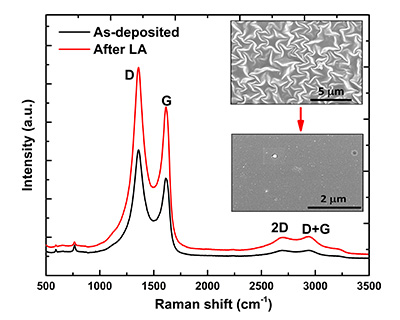Beyond Graphene: Advances Make Reduced Graphene Oxide Electronics Feasible
For Immediate Release
Researchers at North Carolina State University have developed a technique for converting positively charged (p-type) reduced graphene oxide (rGO) into negatively charged (n-type) rGO, creating a layered material that can be used to develop rGO-based transistors for use in electronic devices.

“Graphene is extremely conductive, but is not a semiconductor; graphene oxide has a bandgap like a semiconductor, but does not conduct well at all – so we created rGO,” says Jay Narayan, the John C. Fan Distinguished Chair Professor of Materials Science and Engineering at NC State and corresponding author of a paper describing the work. “But rGO is p-type, and we needed to find a way to make n-type rGO. And now we have it for next-generation, two-dimensional electronic devices.”
Specifically, Narayan and Anagh Bhaumik – a Ph.D. student in his lab – demonstrated two things in this study. First, they were able to integrate rGO onto sapphire and silicon wafers – across the entire wafer.
Second, the researchers used high-powered laser pulses to disrupt chemical groups at regular intervals across the wafer. This disruption moved electrons from one group to another, effectively converting p-type rGO to n-type rGO. The entire process is done at room temperature and pressure using high-power nanosecond laser pulses, and is completed in less than one-fifth of a microsecond. The laser radiation annealing provides a high degree of spatial and depth control for creating the n-type regions needed to create p-n junction-based two-dimensional electronic devices.
The end result is a wafer with a layer of n-type rGO on the surface and a layer of p-type rGO underneath.
This is critical, because the p-n junction, where the two types meet, is what makes the material useful for transistor applications.
The paper, “Conversion of p to n-type Reduced Graphene Oxide by Laser Annealing at Room Temperature and Pressure,” is published in the Journal of Applied Physics. Bhaumik is lead author. The work was done with support from the National Science Foundation.
-shipman-
Note to Editors: The study abstract follows.
“Conversion of p to n-type Reduced Graphene Oxide by Laser Annealing at Room Temperature and Pressure”
Authors: Anagh Bhaumik and Jagdish Narayan, North Carolina State University
Published: March 29, Journal of Applied Physics
DOI: 10.1063/1.4979211
Abstract: Physical properties of reduced graphene oxide (rGO) are strongly dependent on the ratio of sp2 to sp3 hybridized carbon atoms and the presence of different functional groups in its structural framework. This research for the very first time illustrates successful wafer scale integration of graphene-related materials by pulsed laser deposition (PLD) technique, and controlled conversion of p to n-type 2D rGO by pulsed laser annealing using nanosecond ArF excimer laser. Reduced graphene oxide is grown onto c-sapphire by employing pulsed laser deposition in laser MBE chamber and is intrinsically p-type in nature. Subsequent laser annealing converts p into n-type rGO. The XRD, SEM, and Raman spectroscopy indicate the presence of large-area rGO onto c-sapphire having Raman-active vibrational modes: D, G, and 2D. High-resolution SEM and AFM reveal the morphology due to interfacial instability and formation of n-type rGO. Temperature-dependent resistance data of rGO thin films follow Efros-Shklovoskii variable-range-hopping (ES-VRH) model in the low-temperature region and Arrhenius conduction in the high-temperature regime. The photoluminescence (PL) spectra also reveal a less intense and broader blue fluorescence spectra, indicating the presence of miniature sized sp2 domains in the vicinity of π* electronic states, which favor the VRH transport phenomena. The XPS results reveal a reduction of the rGO network after laser annealing with C/O ratio measuring as high as 23% after laser-assisted reduction. The p to n-type conversion is due to the reduction of rGO framework which also decreases the ratio of the intensity of D peak to that of G peak as it is evident from the Raman spectra. This wafer scale integration of rGO with c-sapphire and p to n-type conversion employing laser annealing technique at room temperature and pressure will be useful for large-area electronic devices and will open a new frontier for further extensive research in graphene-based functionalized 2D materials.
- Categories:


